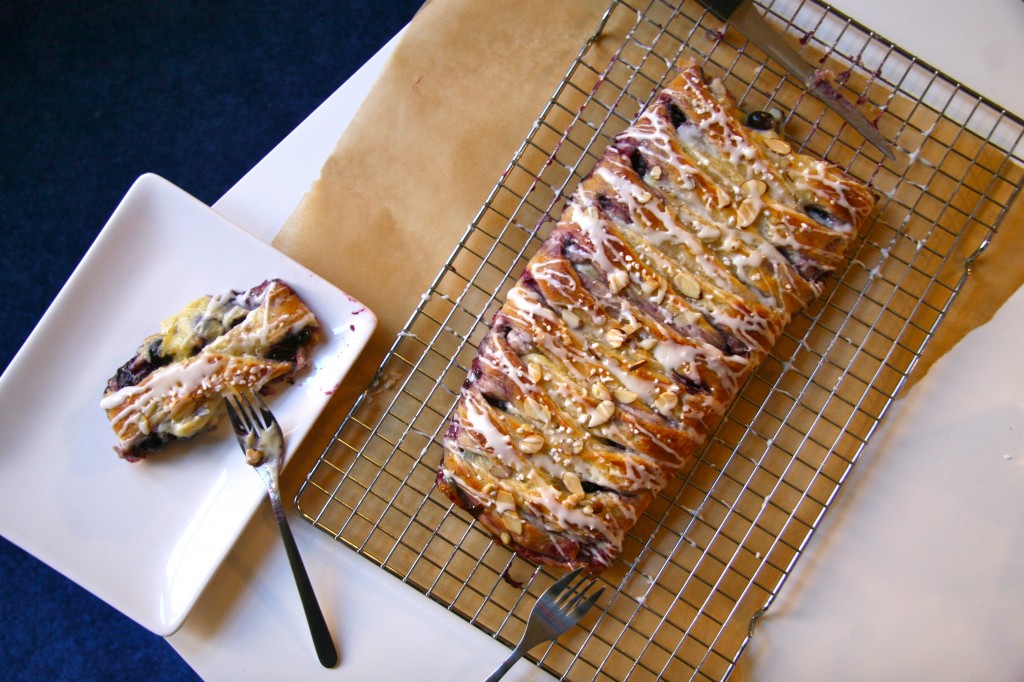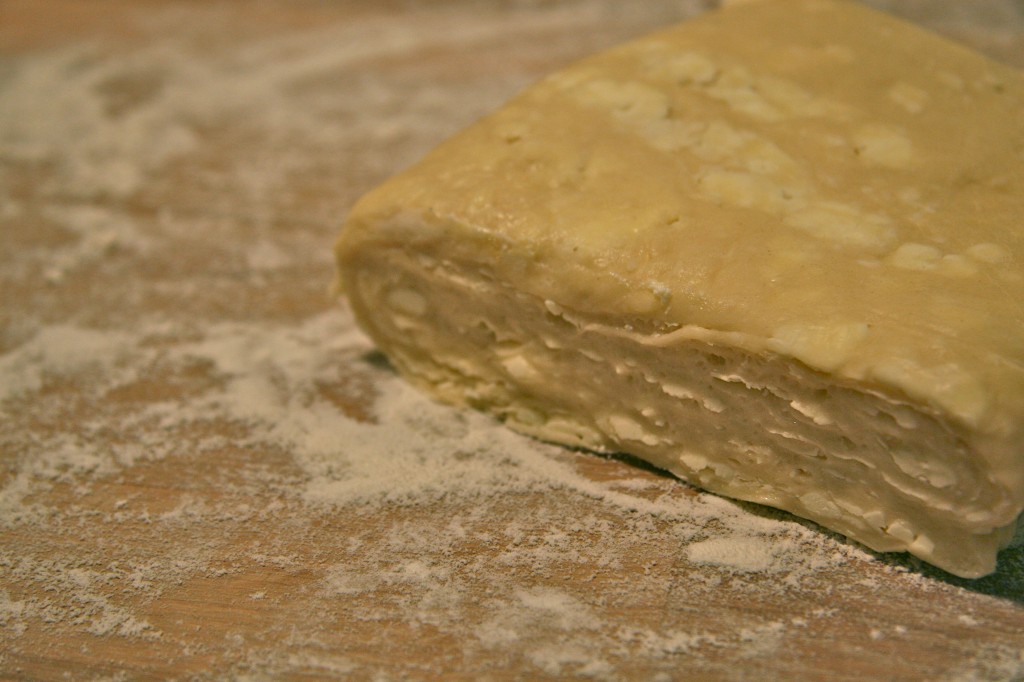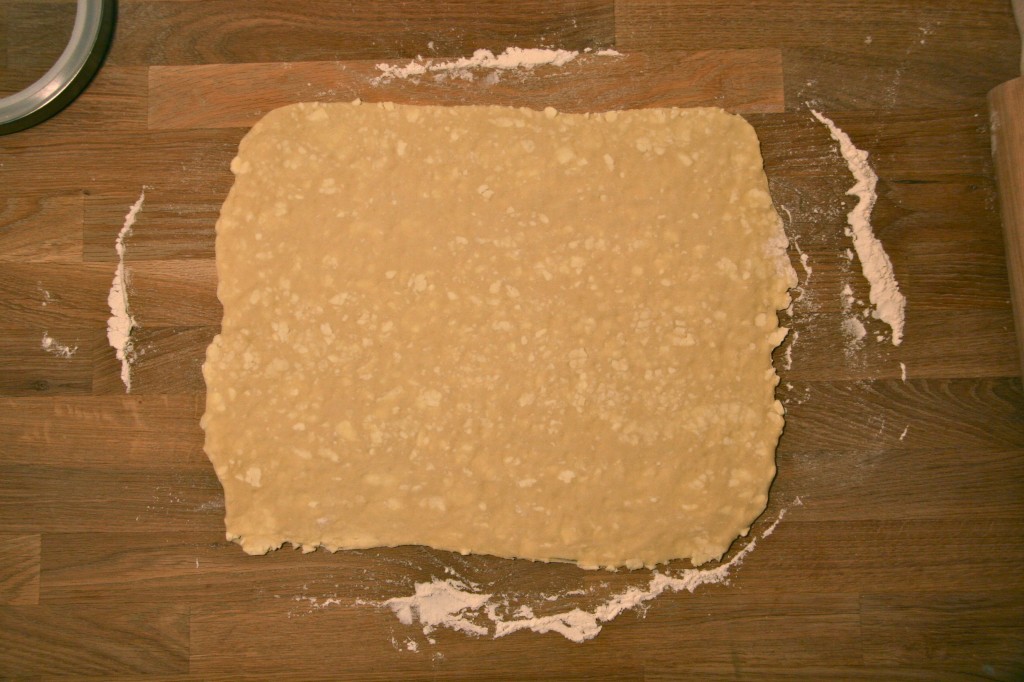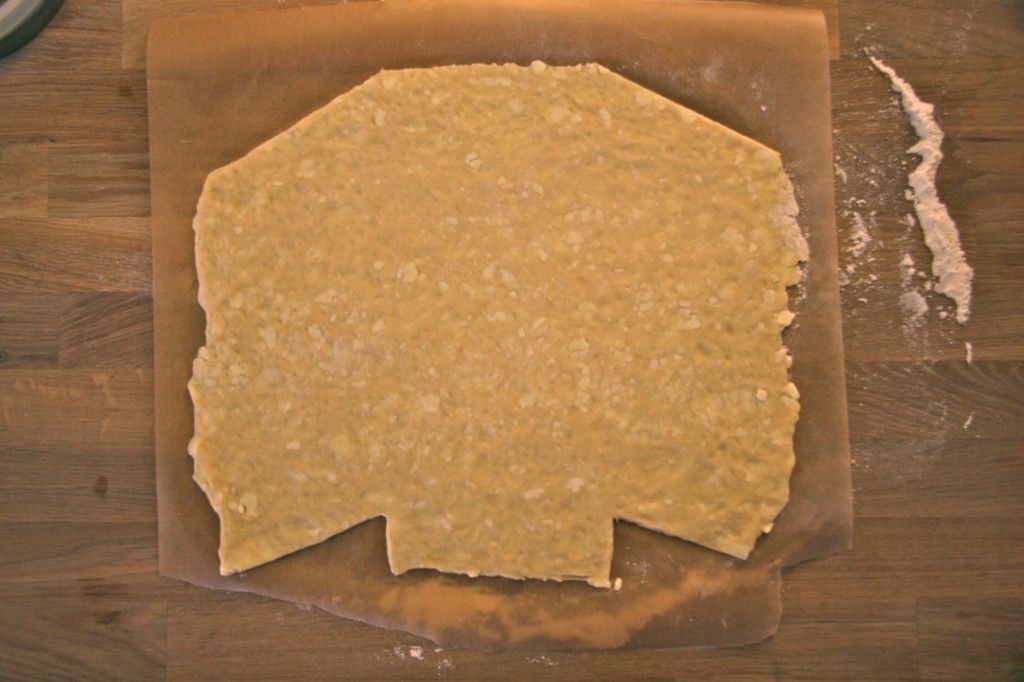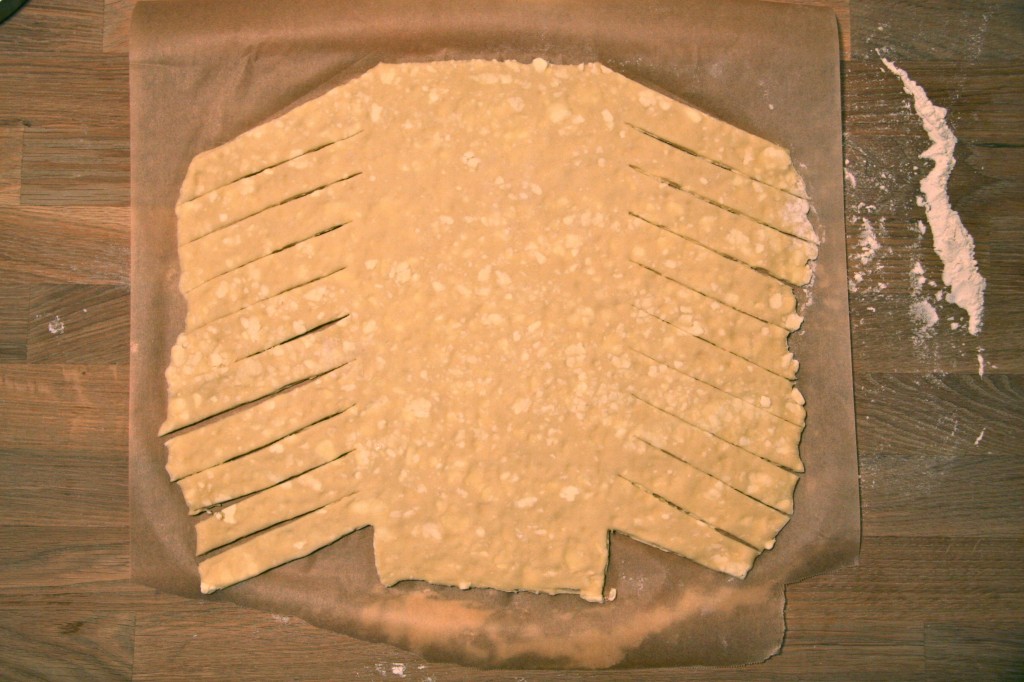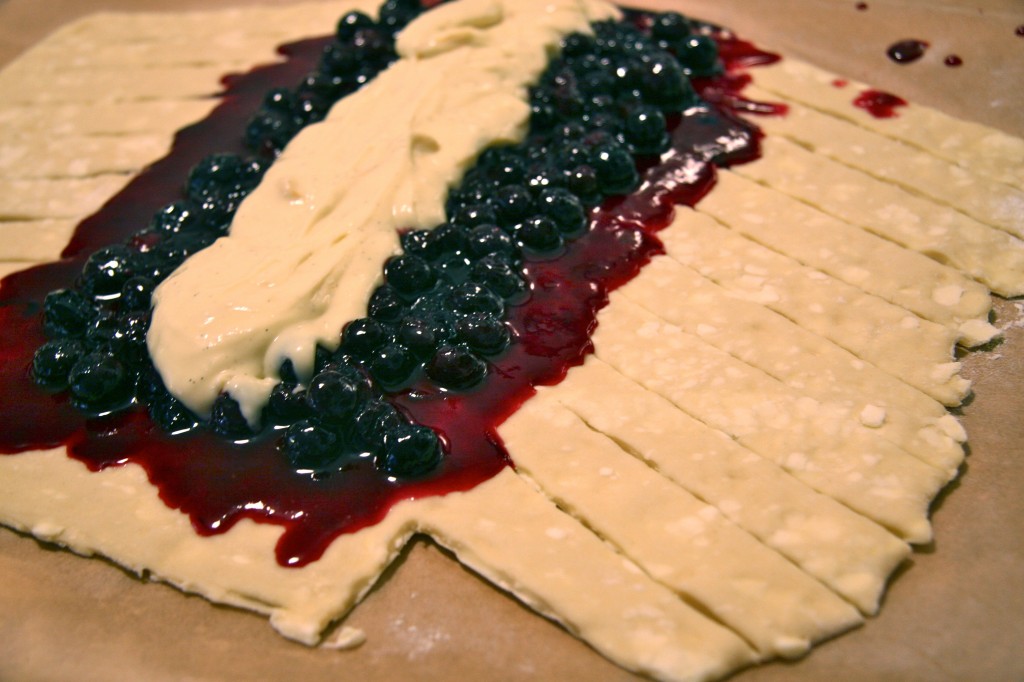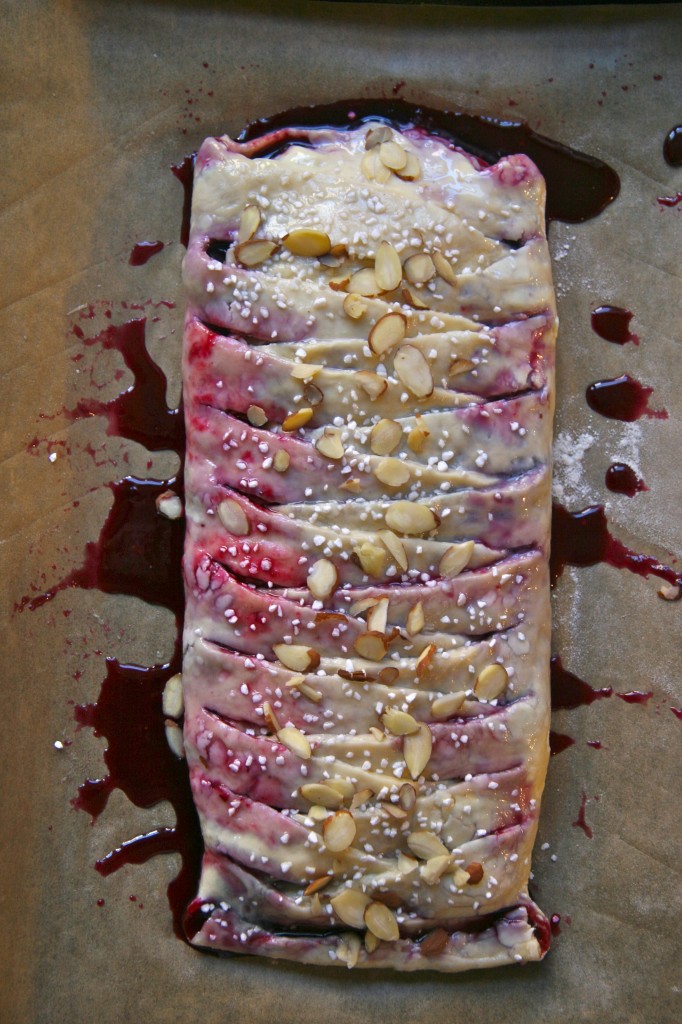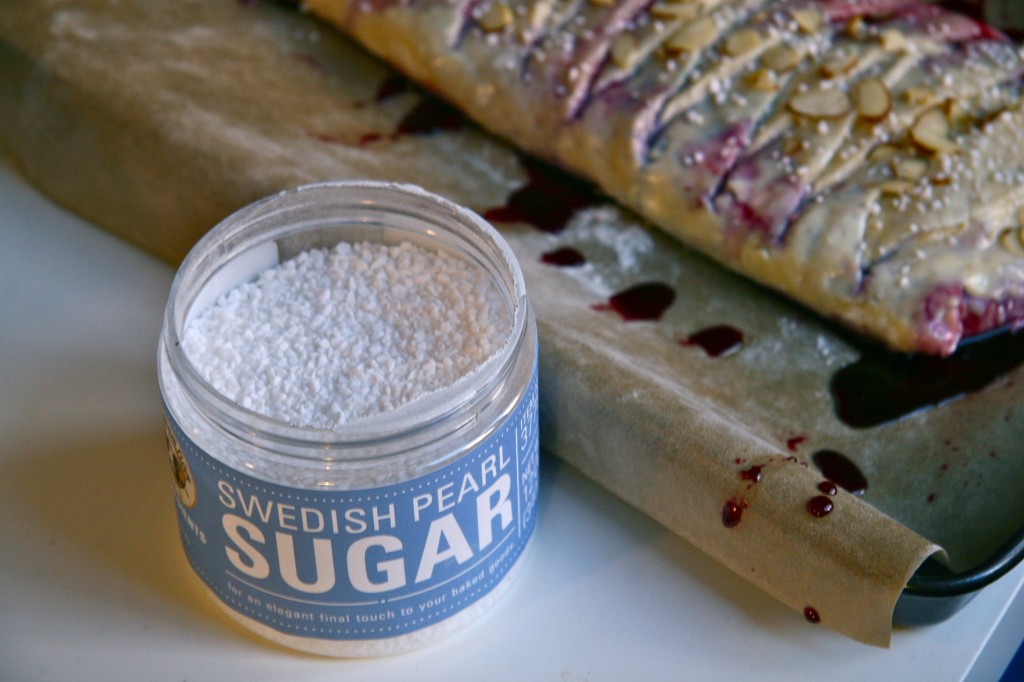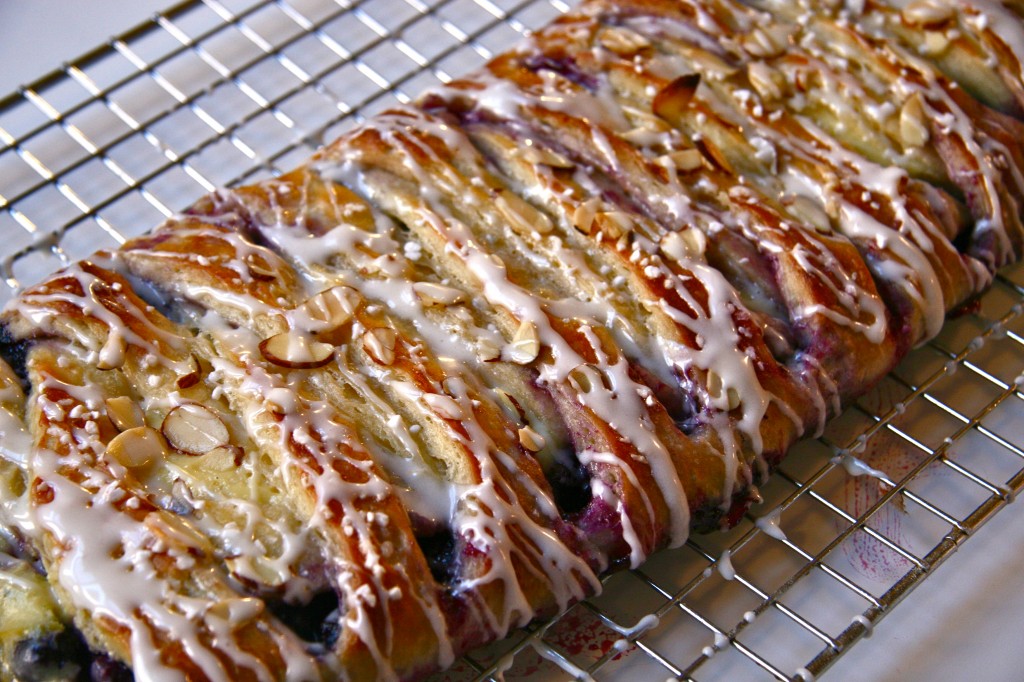A sophisticated braid of flaky, buttery, lightly sweet dough filled with juicy blueberries and creamy cheese filling, speckled with vanilla beans and a little lemon zest.
I distinctly remember eating a certain almond Danish when I was studying in Italy (a certain one, but certainly not just once). The top was sprinkled generously with sweet, white dots of sugar along with slivered almonds.
If you’ve been to Europe, or to a European bakery, you may’ve noticed the pastries frequently have thick white sugar dotting their tops, a Scandinavian tradition, or so I conclude from my research. Each time I ate Danish in Europe, I noticed those sugar pearls and wondered if bakeries in the U.S. used this as well. I’m sure some had, and presumably more now, but I liked to believe that this sugar was somehow magical and only existed in the sweet back rooms of European bakeries. Isn’t it funny how you notice the tiniest nuisances of another culture when traveling? Often, things go overlooked in your own home; until you return with fresh eyes (like how large a jar of peanut butter or a jug of milk looks in the U.S. versus those you may find in Florence, Italy).
Unbelievably, it took me almost five years to buy this sugar when I got back to the U.S., after I discovered it wasn’t so mystical after all. The reason being, I had never considered making the Danishes, croissants, or other yeast-dough pastries they adorn, at home. I was intimidated and thought it’d be too time consuming or too frustrating or something only those who have attended pastry school could tackle.
I was so wrong—and I now kick myself for not having attempted sooner. Oh, the breakfasts I could have had in college!
You too can make Danish at home. Specifically—if you follow this recipe, which I selfishly think you’ll love—you can make a Blueberry and Cheese Danish Braid. It’s not hard, though does require a little preparation to give the yeast time to rise in the refrigerator after the dough is mixed.
So, decide when you want to eat the pastry and plan to make the dough the day or night before. You could also make the fillings ahead and keep refrigerated. Promise me you won’t be intimidated by the length of the recipe, I wrote it out to make it as easy as possible! You can try filling the Danish Braid with lots of flavor combinations if you aren’t fond of blueberries and creamy cheese (I believe the other word for that is crazy . . . kidding!). Please try it with whatever you like best: cherry, strawberry, raspberry, nutella, pastry cream, lemon curd, etc.
Whether or not you have pearl sugar on hand, the Danish experience will still be magical!
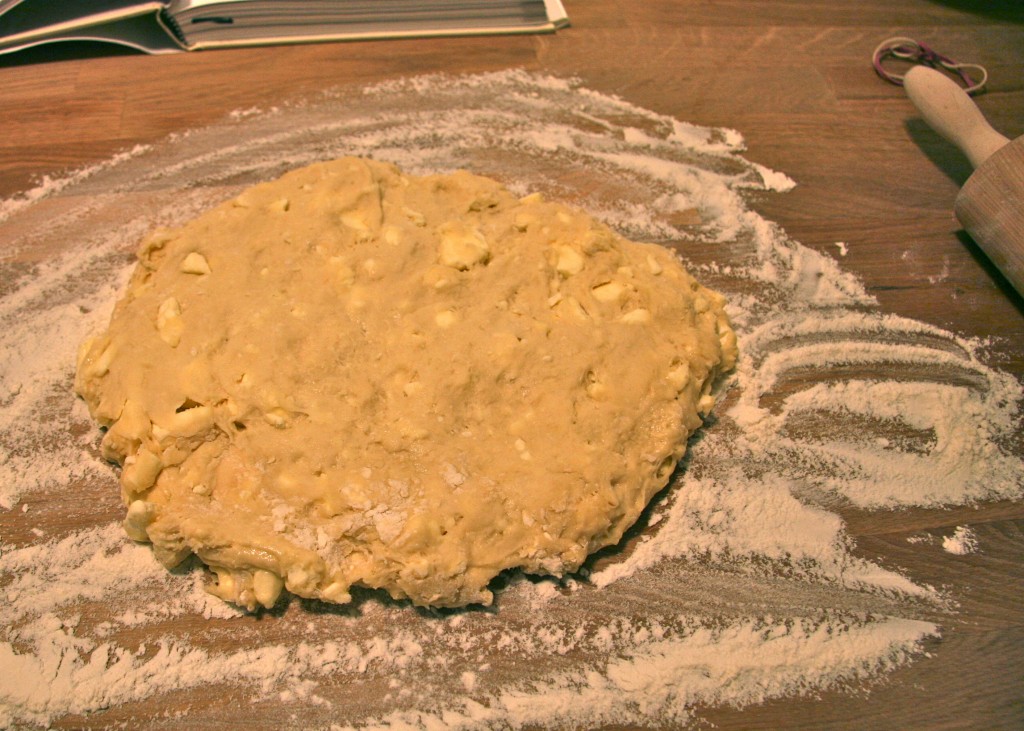
After dough is initially chilled overnight, you can begin shaping it to create the flaky layers that will be the danish.
*Apologies for the format of this recipe versus previous recipes. I felt it would be easier to read written out this way because there are multiple components.
Blueberry and Cheese Danish Braid
Adapted from Beatrice Ojakangas via Baking with Julia, Ina Garten
Makes 2 long braids; about 6-8 servings each. If you’d like to make just one braid, cut the dough in half after the roll and fold stage and freeze up to one month.
Prep Time: 1 hour 30 minutes
Total Time: At least 8 hours (including chilling time)
For the pastry:
¼ cup warm water (between 105-115 degrees F)
2 ½ teaspoons active dry yeast
½ cup milk, at room temperature (I used 2%, but any milk fat level will work.)
1 large eggs, at room temperature
¼ cup granulated sugar
1 teaspoon salt
2 ½ cups unbleached all purpose flour
2 sticks (8 ounces) cold unsalted butter
1 egg white mixed with 1 tablespoon water, for egg wash
¼ cup slivered almonds (optional)
1 tablespoon pearl sugar (optional)
3-4 teaspoons cold heavy cream, for glaze (optional)
½ cup confectioners sugar, for glaze (optional)
For the Blueberry Filling
2 cups fresh blueberries (other berries can be substituted here)
1 cup sugar
1 teaspoon cornstarch
1 to 2 tablespoons fresh lemon juice
For the Cream Cheese Filling
8 ounces cream cheese, at room temperature
1/3 cup sugar
2 large egg yolks, at room temperature
2 tablespoons ricotta cheese
1 teaspoon pure vanilla bean paste, or extract
1/4 teaspoon salt
1 tablespoon grated lemon zest (about 1 lemon)
Instructions:
Prepare the dough: Pour the water into a large bowl, sprinkle the yeast over it, and let both soften for two minutes. Add the milk, egg, sugar, and salt and whisk together. Set aside. Put the flour in the bowl of a food processor fitted with the metal blade. Cut the butter into ¼ – ½ inch thick slices and drop them onto the flour. Pulse 8 to 10 times, until the butter is cut into pieces that are about ½ inch in diameter, but not any smaller than that. If in doubt, stop when the pieces are larger. It’s better that way, than to over mix. Empty the butter flour mixture into the bowl with the yeast and, using a rubber spatula, gentle turn the mixture over, just until the dry ingredients are moistened. Be cautious not to over mix. You’ll want to see pieces of butter throughout the dough – this will ensure it is flaky. Cover the bowl with plastic wrap and refrigerate overnight (up to 4 days).
Roll the dough: After the dough has chilled overnight, lightly flour a work surface and turn the dough onto it. Dust the top of the dough with flour. Roll the dough into a square about 16 inches on each side (the dough might be sticky, so keep the flour close and cover the rolling pin as needed. You can also cover the dough and chill it again if it becomes too soft to roll). Fold the dough into the middle in thirds, like a business letter that you’re going to put in an envelope. Turn it so that the closed fold is to your left. Roll the dough out again, this time into a long narrow rectangle, about 10 inches wide by 24 inches long. Fold the rectangle in thirds again, turn it so the closed fold is to your left, and roll into a 20 inch square. Fold the square in thirds, like a business letter, so that you have a rectangle. Roll the dough out into a rectangle about 10 inches wide by 24 inches long. Fold the dough in thirds again, wrap it tightly with plastic wrap and chill for at least 30 minutes (up to 2 days. If not using after 2 days, the dough can be frozen at this point for 1 month, thawing overnight in a refrigerator before use.)
Prepare the Blueberry filling: Stir the berries and sugar together in a small saucepan over medium heat. Heat until sugar has dissolved, stirring frequently. Add lemon juice and cornstarch and cook 1-2 more minutes. Transfer to a bowl. Cover and refrigerate until fully cooled.
Prepare the Cream Cheese Filling: Place the cream cheese and sugar in the bowl of an electric mixer fitted with a paddle attachment and cream them together on low speed until smooth. With the mixer still on low, add the egg yolks, ricotta, vanilla, salt, and lemon zest and mix until just combined. Keep away from anyone who likes cream cheese or you might find some missing.
Shape the dough: After the dough has chilled from rolling and folding, lightly flour a work surface and roll the chilled dough into a rectangle 10 inches wide and 16 inches long (eyeball it). Lift onto a sheet of parchment paper and position the dough so the lengthy side is perpendicular to you. Cut the two top corners off the dough at an angle slanting downward and cut two small triangles out of the bottom of the dough. This will frame the space in the middle third of the dough for the filling, see image above. Using a sharp knife cut 10-12 slanting lines down each side, angling the cuts downward, not crossing over the space you framed for the filling, see image above.
Fill and Braid the dough: Spread some of the blueberry filling down the length of the dough (there will be juice leftover. Use the chunky portion. Spoon the cream cheese filling in a narrow line down the center of the blueberry filling. Fold the strips of the pastry into the center over the filling, alternating folding from the left side and the right side until you’ve reached the bottom. Brush the pastry with the egg wash and sprinkle with almonds and pearl sugar, if using. Allow the Danish to sit at room temperature while you preheat the oven.
Baking the Braid: Preheat the oven to 400 degrees F. Slide the braid, parchment and all, onto a baking sheet. Bake for 15 to 20 minutes, or until golden, rotating once or twice during baking. Transfer the pastry to a cooling rack and prepare the glaze, if using. To prepare the glaze, stir the cream into the confectioners sugar in a small bowl, adding just enough until it produces a smooth, shiny glaze. Using a spoon or fork, drizzle the glaze over the pastry. Serve the pastry warm, or at room temperature.
